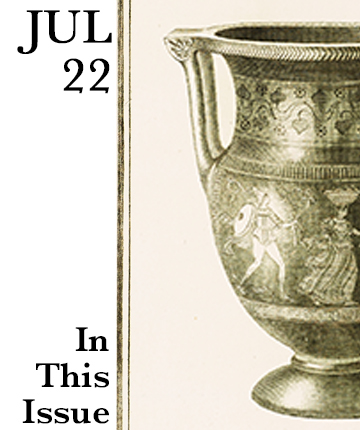 It has been a bit of an internal fight to clearly see the through line of the five July articles. They are distinct, but not entirely disparate. There is the essence of seeing and knowing, or at least coming to know, in each story. There is also an aspirational thread, the full on being that happens once we are past chronicling observations – past naming and synthesizing the observations – when we set down the tools of measurement and become.
It has been a bit of an internal fight to clearly see the through line of the five July articles. They are distinct, but not entirely disparate. There is the essence of seeing and knowing, or at least coming to know, in each story. There is also an aspirational thread, the full on being that happens once we are past chronicling observations – past naming and synthesizing the observations – when we set down the tools of measurement and become.
But the connection keeps going in and out of focus as I try to name the intangible.
In a recent conversation, a colleague shared a question posed to her by an art director, “What is the dominant trend in ceramics right now?” No doubt other art directors, curators, historians, theorists, artists – all of us engaged in this realm of craft and making – have likely rolled a similar query around from time to time. What has stayed with me from the exchange, and what I think about in relation to the stories this month, is the answer: material commitment. Others engaged in the exchange formalized the notion of material commitment by defining it as neo formalism, evidence of artists desiring physicality of material. It was suggested that the devices in play, against the backdrop of this material commitment, were emotional contexts of humanity and beauty and understanding humor.
Material, ceramic or not, is the maker’s nonverbal language. It is how we respond to the world around us and how we process events viscerally. We have access to a language beyond words. And I can see that in each story, that the protagonist is driven by, guided by material commitment, material examination. Trusting in material commitment they know they will not find one concrete verbal answer, but they will recognize from the material and the way energies move around the material when they have arrived at knowing, when they are on the right path of query.
Looking through the Studio Potter archives in search of an example that would better ground the point I’m trying to make – with words – I found a story by Louise Cort, “Looking with the Heart,” from Volume 17 Number 1, an issue organized around the concept of perception, from 1988. In the article Cort shares a conversation she had with a Japanese potter:
I asked him about how he had been taught to see, and he responded with a parable: "Look at things with the heart" (kokoro de mono wo miru). By way of explanation, he followed with examples. The samisen player is taught to memorize the music and then play without a score. Only that way can she sit upright, with back straight, and pour her energy into the instrument. If she has to follow a score, she bends over, and her music is weak and hesitant. The archer is taught to shoot with eyes closed. (The potter's grandfather used to practice outdoors at night.) Only then can he hit a target whose position is known with the whole mind and body.
This is the through line, but it comes in and out of focus because each article conveys a different stage of the process of seeing and knowing. Every story is a different stage: becoming, about to become, are, will be, what may be…
You’ll see.
How Removing Distance Can Bring Us Closer to Answering an Age-Old Question
by Peter Pincus
Definitions of theft, plagiarism, and appropriation became vital to this evolving dialogue — and again, the value of commingling showed itself. Each student, of course, had a distinct opinion on the question of morality that came from how intellectual property boundaries were drawn in their respective discipline. But collectively, the cohort agreed that learning from imitation was vital to understanding this discipline.
This month’s FREE article and I encourage you to share it with as many people as you can.
Where Everything is Interconnected
by Tony Pandola
The name Roxanne Swentzell may conjure sculptural images in your mind, but she is more than that. “We’re all sensing our world in unique ways; that’s scary for people who want to think we’re not diverse and unique. But even though we’re all part of this whole thing together, there are real differences in experiences. Allowing ourselves to acknowledge that will help us start to have self-respect, to give quality attention to our own unique selves, or others, in ways the label world doesn’t."
by Jill Foote-Hutton
Robbie Lobell and Maryon Attwood are looking to forge new directions for Cook on Clay. Like the rest of the world, they are asking themselves a lot about transition these days. What does retirement look like for a craftsperson in 2022? How does one navigate from the pounding rhythm of production into a slower beat and still afford life?
Puzzling and Beautiful Crazing Patterns
by Howard Sawhill
A journey to uncover factors that influence crazing patterns attempts to provide a plausible explanation for a “puzzling” pattern in a Chinese Guan-ware vase. Along the way, the author ran across an interesting method to create new, unusual crazing patterns.
A delicate metaphor. Seeking of truth.
by Nessim Cohen
The interior design is minimal, the space – easily transformed. The objects do not dominate the space, yet everything operates in support of their display. Carefully arranged, a context is created. The showcase is a microcosm of Atelier Parter’s latest production.
Finally, if you are a member of Studio Potter and you have the means, I want to encourage you to support our 50 for 50 campaign. Our goal is to continue to represent the journeys and questions of our community at an ever-higher level, and your support of our endeavors allows us to continue to grow from here.
Be well everyone, and thanks for reading,

Jill Foote-Hutton, co-editor
